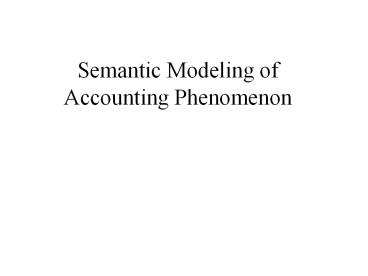Data Modeling for Accountants - PowerPoint PPT Presentation
1 / 17
Title:
Data Modeling for Accountants
Description:
Semantic Modeling of Accounting Phenomenon SMAP Modeling Overview Identify the entities Only model entities with more than one instance Identify business rules for ... – PowerPoint PPT presentation
Number of Views:105
Avg rating:3.0/5.0
Title: Data Modeling for Accountants
1
Semantic Modeling ofAccounting Phenomenon
2
SMAP Modeling Overview
- Identify the entities
- Only model entities with more than one instance
- Identify business rules for those entities
- Relationships between entities
- Cardinality of those relationships
- Integrate the transaction cycles
3
Microwave Warehouse, Inc.
- Arnold Fitzmeyer is the sales manager of
Microwave Warehouse, Inc. (MWI), a distributor of
small kitchen appliances and has asked you to
help him design an effective accounting system
for MWIs revenue cycle.
4
Microwave Warehouse, Inc.
- MWI considers companies that make inquiries to
be customers, even if they have not placed an
order yet. Customers can order any number of
appliances on a single order. Sometimes,
customers order an appliance that MWI does not
have in inventory. In these cases, MWI ships
partial orders however, MWI never includes items
from multiple orders in a single shipment. MWI
records a sale and sends an invoice when they
make a shipment.
5
Microwave Warehouse, Inc.
- Customers pay for appliances received in several
ways. Some customers pay on receipt of the
invoice. MWI sends a bill to customers with
established credit records at the end of each
month for all shipments made in that month. MWI
sends an average of five shipments per month to
its customers. Most larger customers pay the
total of each months invoices in full at the end
of the month. However, some customers pay the
total of their invoices over several months,
particularly when the amount is large or business
is slow. MWI deposits all checks received each
day in their one bank account intact at the end
of each day.
6
Identify the Entities
- Entities are the things about which we are
interested - But not accounting artifacts
- Can use several approaches, including the
McCarthy REA model - Resources
- Events
- Agents
- REAL model includes Locations
7
Identified Entities
Resources Events Agents
8
Expanded Set ofRevenue Cycle Entities
Resources Events Agents
9
Identify Business Rules
- Identify relationships between entities
- Evaluate the cardinality of those relationships
10
Identify Relationships
- Is Inventory related (directly) to
- Sales Order?
- Shipment?
- Cash Receipt?
- Customer?
11
Identify Relationships
- Is Sales Order related (directly) to
- Shipment?
- Cash Receipt?
- Customer?
12
Identify Relationships
- Is Shipment related (directly) to
- Cash Receipt?
- Customer?
13
Identify Relationships
- Is Cash Receipt related (directly) to
- Customer?
14
Identified Relationships
15
Evaluate Cardinality
(min, max)
A
B
- Minimum constraint on A
- Does A occur before B? no0, yes1
- Maximum constraint on A
- Can B have only 1 (1), or many (N) As related to
it?
16
Evaluate Cardinality
(min, max)
A
B
- Minimum constraint on B
- Does B occur before A? no0, yes1
- Maximum constraint on B
- Can A have only 1 (1), or many (N) Bs related to
it?
17
View Integration









![Full Guide on Samsung Data Recovery [Updated] PowerPoint PPT Presentation](https://s3.amazonaws.com/images.powershow.com/9355974.th0.jpg?_=20191101043)





















